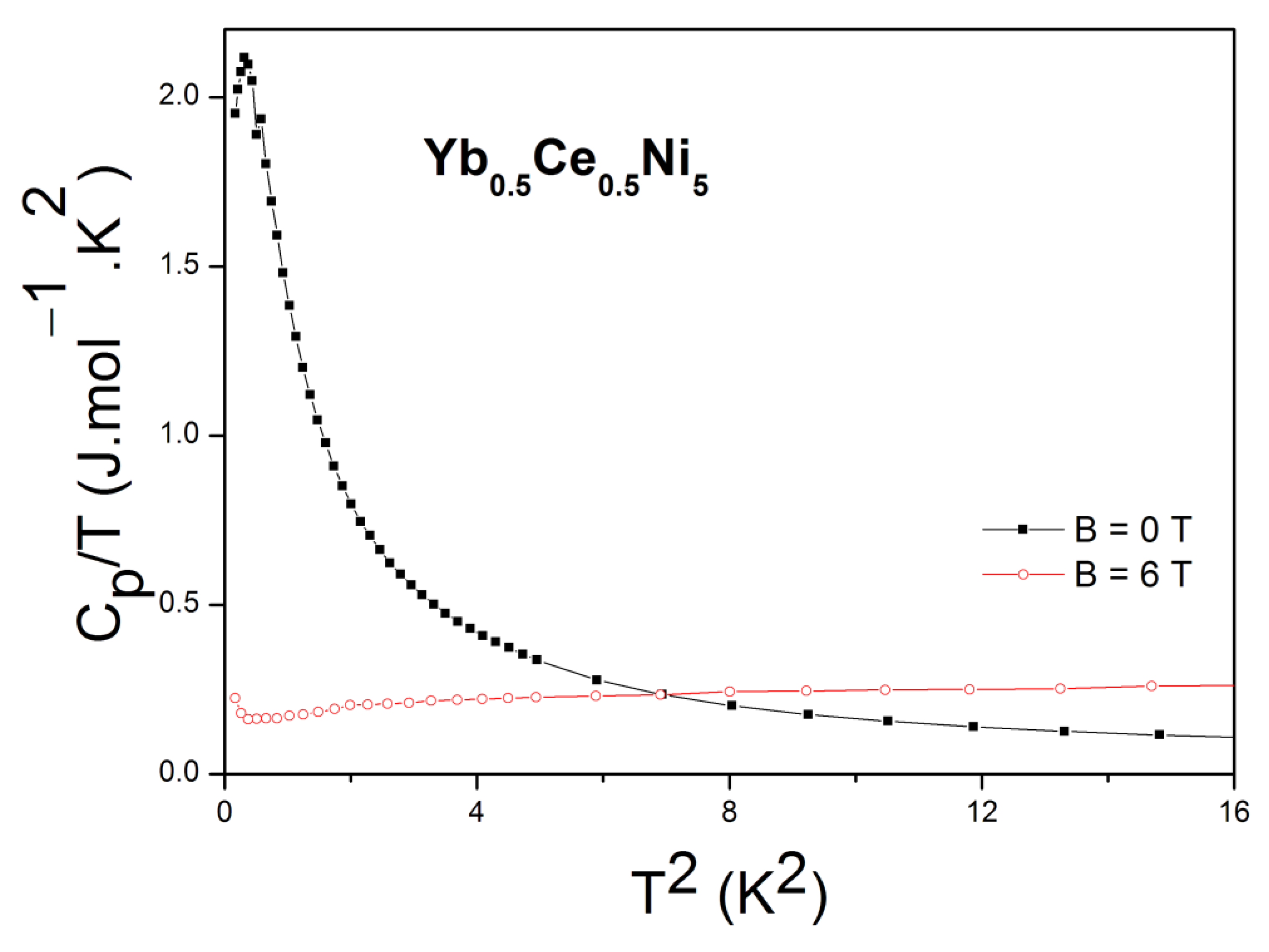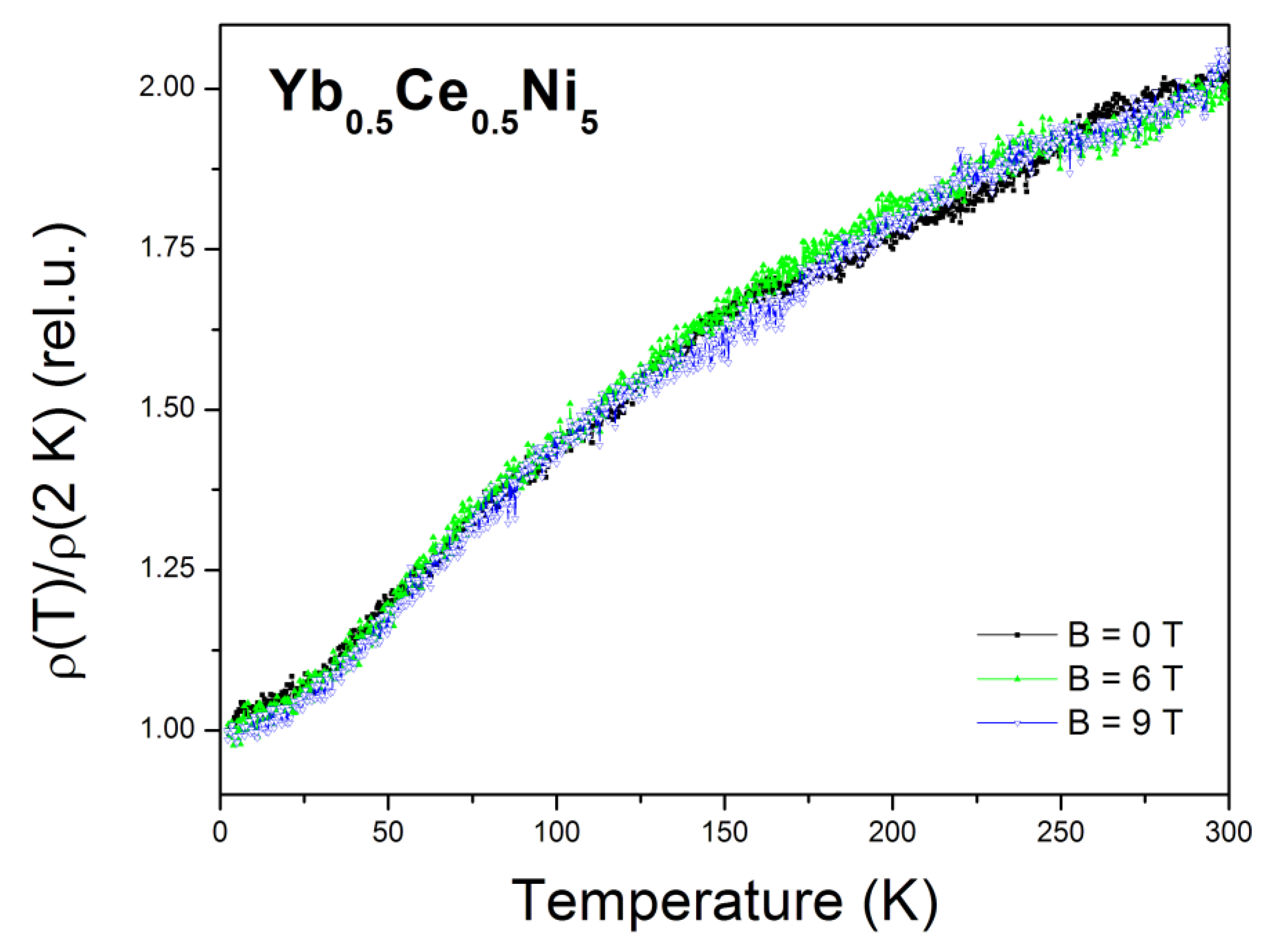3. Results and Discussion
Figure 1a shows the experimental X-ray powder diffraction pattern and the Rietveld refinement performed for Yb
0.5Ce
0.5Ni
5 compound with the FULLPROF suite package (version September 2020, open source software) [
14] under the WinPlotr shell (version April 2019, open source software) [
15]. The Bragg diffraction reflections were correctly identified and indexed based on the hexagonal CaCu
5 crystal structure (space group P6/
mmm), while the lattice parameters obtained were a = b = 0.4869 nm and c = 0.3985 nm. These parameters were located between those of CeNi
5 and YbNi
5. Only a couple of very weak extra peaks in the low theta range were observed. The reliability factors obtained from the Rietveld refinement were R
f = 13.05%, R
B = 15.13%, and Chi
2 = 2.48. In
Table 1, the atomic coordinates are displayed.
The morphological analysis of the studied sample is presented in
Figure 1b. From more than 10 EDX spectra (not shown) collected from the sample surface, it was determined that, within the experimental error (0.1 at. %), the small discrepancies between the synthesis compositions and the measured compositions may be due to the presence of traces of some spurious phases, as evidenced by the very weak extra peaks present in the XRD at low angles.
The temperature dependence of the magnetization in the applied magnetic fields (
B = 0.1 T and
B = 0.01 T) is displayed in
Figure 2a. The broad maximum connected with spin fluctuations is visible at around
T = 40 K. At lower temperatures, an upturn of magnetization occurs, which, in the case of CeNi
5, was interpreted in different ways. Some authors believe that it is associated with the intrinsic properties of the material, which is on the verge of ferromagnetism [
16,
17]. On the other hand, it is known that even small concentrations (in the order of tens of ppm) of magnetic impurities can cause such an upturn. Earlier investigations of CeNi
5 material do not show low-temperature upturns in magnetic susceptibility measurements [
18,
19,
20,
21], indicating that this effect does not arise from intrinsic properties but from ferromagnetic impurities. Instead, the broad maximum at 100 K in the magnetic susceptibility for pure CeNi
5 is an intrinsic property mediated by spin fluctuations. The shifting of this maximum to lower temperatures observed in magnetization in Yb
0.5Ce
0.5Ni
5 may be related to the competition of magnetic order and spin fluctuation which is present in this sample, which was prepared midway between CeNi
5 and ferromagnetic YbNi
5 [
10]. By applying increasing magnetic fields, the temperature where the maximum occurs was not shifted, but its intensity decreased. From the Curie–Weiss law and its higher temperature fit, a paramagnetic Curie temperature
θP = −32.33 K and an effective paramagnetic moment of
μeff = 4.07 μ
B/f.u were obtained (
Figure 2a in the inset at the top). The negative value of the paramagnetic Curie temperature indicates a dominating antiferromagnetic exchange interaction in a high temperature range. The value of the effective paramagnetic moment (4.07 μ
B/f.u.) is slightly smaller than the free Yb
3+ ion value (4.54 μ
B/f.u.).
If we consider the trends of lattice parameters from YbNi5 (a = 0.4841–0.4850 nm, c = 0.3957–0.3968 nm) and CeNi5 (a = 0.4870–0.4890 nm, c = 0.4000–0.4013 nm), it can be determined that the lattice parameters of Yb0.5Ce0.5Ni5 are in between the narrow range of parameters of the two binary compounds. This fact seems to indicate a scenario where Ce and Yb valences are unchanged in the solid solution compared to the binary compounds—i.e., almost 4+ for Ce and 3+ for Yb ions. In fact, with Ce3+ being larger than Ce4+, a change in Ce valence would increase the lattice parameters of Yb0.5Ce0.5Ni5. To verify this, one should investigate this compound using spectroscopic techniques such as XPS. On the other hand, we observed a possible magnetic order at low temperatures (see the section on heat capacity), which should correspond to Yb in the magnetic 3+ state. In fact, it is well known that if the valence of Yb decreased to, e.g., 2.9, this would be sufficient for the magnetic order to vanish. Finally, the slightly lower value of the effective moment obtained with respect to the free Yb3+ ion value may be due to the contribution of the “almost” 4+ valence state of Ce.
The isothermal magnetization is plotted in
Figure 2b as a function of the applied magnetic field up to 5 T at different temperatures. The tendency towards saturation is evident, and the ordering temperature is expected to be below 2 K. The Arrott plot for Yb
0.5Ce
0.5Ni
5 is presented as the inset in
Figure 2b. The nature of the magnetic transition can be obtained by analyzing the Arrott isotherms giving
M2 as a function of
B/M. The “
S” shape of the Arrott plot is typical for temperatures above the critical temperature. According to the Banerjee criterion [
22], this method allows us to determine the nature of the magnetic transition depending on the slope of the
M2 vs. (
B/M) plots at high magnetic fields. Indeed, a positive slope indicates a second-order magnetic transition. The Banerjee criterion shows that these curves present a positive slope at high magnetic fields, implying that this compound exhibits a second-order phase transition.
The heat capacity measurement of Yb
0.5Ce
0.5Ni
5 up to 300 K (not plotted) shows a typical metallic behavior and, in the high-temperature range, it follows the Dulong–Petit law
3nR~150 J/mol·K. From the
C(
T)/
T vs.
T2 dependence (shown in
Figure 3), at 6 T the magnetic order is suppressed, and it is possible to estimate the electronic Sommerfeld
γ coefficient as
γ6T~200 mJ/mol·K
2.
In
Figure 4, the low temperature dependence of the heat capacity is shown for various values of applied magnetic fields up to 6 T. We observe at around 0.8 K a sharp anomaly in the zero magnetic field. By increasing the magnetic fields, this anomaly evolves, with its intensity increasing, shifting to higher temperatures, and becoming broader, similar to the trends observed in other Yb systems [
23]. The sharp anomaly at 0.8 K may be associated with a magnetic order, but this should be confirmed by magnetic measurements below 1 K.
Figure 5 shows the electrical resistivity between 0.5 K and 300 K for different magnetic fields. The measurements detect a typical metal behavior.
Author Contributions
Conceptualization, A.D., M.R. and M.G.; methodology, A.D., M.R. and M.G.; validation, A.D., M.R., M.G., R.V., J.R.F. and J.C.G.S.; formal analysis, M.G. and M.R.; investigation, A.D., M.R. and M.G.; resources, A.D., M.R. and M.G.; data curation, K.A. and A.D.; writing—original draft preparation, A.D., M.R. and M.G.; writing—review and editing, A.D., M.R. and M.G.; visualization, A.D. and M.R.; supervision, J.R.F. and J.C.G.S. and R.V.; project administration, M.R. and R.V. All authors have read and agreed to the published version of the manuscript.
Funding
This research was funded by the Slovak Grant Agency VEGA 1/0404/21 (Materials with emergent behaviour and application possibilities under extreme physical conditions influence); VEGA 1/0705/20 (Novel rare earth based intermetallic compounds - crystal structure and physical properties of their ground state); VEGA 1/0053/19 (Influence of chemical composition on unique physical properties of modern functional materials) and APVV-16-0079 (Modern amorphous and polycrystalline functional materials for sensors and actuators.
Institutional Review Board Statement
Not applicable.
Informed Consent Statement
Not applicable.
Data Availability Statement
The data that support the findings of this study are available from the corresponding author upon reasonable request.
Conflicts of Interest
The authors declare no conflict of interest.
References
- Dzubinska, A.; Reiffers, M.; Espeso, J.I.; Rodriguez Fernandez, J. Magnetic and heat capacity study of the new Gd1-xCexNi5 series. Acta Phys. Pol. A 2017, 131, 997–999. [Google Scholar] [CrossRef]
- Rashid, T.P.; Arun, K.; Curlik, I.; Ilkovic, S.; Reiffers, M.; Dzubinska, A.; Nagalakshmi, R. Influence of spin fluctuations on the magnetocaloric behavior of Gd2Co3Al9 compound. J. Magn. Magn. Mater. 2018, 466, 283–288. [Google Scholar] [CrossRef]
- Sereni, J.G.; Curlik, I.; Giovannini, M.; Strydom, A.; Reiffers, M. Physical properties of the magnetically frustrated very-heavy-fermion compound YbCu4Ni. Phys. Rev. B 2018, 98, 094420. [Google Scholar] [CrossRef] [Green Version]
- Bajorek, A.; Chelkowska, G.; Andrejewski, B. Magnetic properties, crystal and electronic structure of GdNi5−xCux series. J. Alloys Compd. 2011, 509, 578–584. [Google Scholar] [CrossRef]
- Carretta, P.; Giovannini, M.; Horvatic, M.; Papinutto, N.; Rigamonti, A. Dynamical susceptibility and magnetic-field effect at the quantum critical point in CeCu6−xAux from Cu NQR-NMR relaxation. Phys. Rev. B 2003, 68, 220404. [Google Scholar] [CrossRef]
- Gegenwart, P.; Si, Q.; Steglich, F. Quantum criticality in heavy-fermion metals. Nat. Phys. 2008, 4, 186–197. [Google Scholar] [CrossRef]
- Von Lohneysen, H.; Rosch, A.; Vojta, M.; Wolfle, P. Fermi-liquid instabilities at magnetic quantum phase transitions. Rev. Mod. Phys. 2007, 79, 1015. [Google Scholar] [CrossRef] [Green Version]
- Custers, J.; Gegenwart, P.; Wilhelm, H.; Neumaier, K.; Tokiwa, Y.; Trovarelli, O.; Geibel, C.; Steglich, F.; Pepin, C.; Coleman, P. The break-up of heavy electrons at quantum critical point. Nature 2003, 424, 524. [Google Scholar] [CrossRef] [Green Version]
- Gignoux, D.; Givord, F.; Lemaire, R.; Tasset, F. Intermediate valence state of cerium in CeNi. J. Less Common Met. 1983, 94, 165–172. [Google Scholar] [CrossRef]
- Hodges, J.A.; Bonville, P.; Ocio, P. Magnetic properties of YbNi5 from 170Yb Mossbauer and magnetisation measurements. Eur. Phys. J. B 2007, 6, 365–370. [Google Scholar] [CrossRef]
- Gignoux, D.; Givord, F.; Lemaire, R.; Tasset, F. Thermal dependence of the susceptibility densities in CeNi5. J. Phys. Colloq. 1982, 43, C7. [Google Scholar] [CrossRef] [Green Version]
- Gignoux, D.; Givord, F.; Lemaire, R.; Tasset, F. Spatial distribution of the induced magnetization in CeNi. J. Magn. Magn. Mater. 1985, 50, 53–58. [Google Scholar] [CrossRef]
- Reiffers, M.; Della Mea, M.; Bauer, E.; Pristas, G.; Vasilova, M. Pressure and Field Effects on Spin Fluctuations in Ce0.8RE0.2Ni5 (RE = Pr, Nd). J. Phys. Soc. Jpn. 2007, 76, 68–69. [Google Scholar] [CrossRef] [Green Version]
- Rodriguez-Carvajal, J. Recent advances in magnetic structure determination by neutron powder diffraction. Physica B 1993, 192, 55–69. [Google Scholar] [CrossRef]
- Roisnel, T.; Rodriguez-Carvajal, J. WinPLOTR: A windows tool for powder diffraction patterns analysis. In Proceedings of the Seventh European Powder Diffraction Conference (EPDIC 7), Materials Science Forum, Barcelona, Spain, 20–23 May 2000; pp. 118–123. [Google Scholar]
- Nasu, S.; Neumann, H.; Marzouk, N.; Craig, R.S.; Wallace, W.E. Specific heats of LaNi5, CeNi5, PrNi5, NdNi5 and GdNi5 between 1.6 and 4 K. J. Phys. Chem. Solids 1971, 32, 2779–2783. [Google Scholar] [CrossRef]
- Tang, J.; Li, L.; O’Connor, C.J.; Lee, Y.S. Strongly enhanced paramagnetism in CeNi5—xGax and LaNi3Ga2. J. Alloys Compd. 1994, 207, 241–244. [Google Scholar] [CrossRef]
- Reiffers, M.; Della Mea, M.; Bauer, E.; Pristas, G. Pressure and field effects on spin fluctuations on CeNi5. J. Magn. Magn. Mater. 2004, 272–276, 605–607. [Google Scholar] [CrossRef]
- Musil, O.; Svoboda, P.; Divis, M.; Sechovsky, V. Specific-heat and magnetization studies in Ce(NixCu1-x)5 heavy-fermion compounds. Czechoslov. J. Phys. 2004, 54, 311–314. [Google Scholar] [CrossRef]
- Coldea, M.; Andreica, D.; Bitu, M.; Crisan, V. Spin fluctuations in YNi5 and CeNi5. J. Magn. Magn. Mater. 1996, 157, 627–628. [Google Scholar] [CrossRef]
- Zapotokova, M.; Curlik, I.; Giovannini, M.; Reiffers, M. Study on effect of Ge doping on CeNi5. Eur. Phys. J. B 2013, 86, 129. [Google Scholar] [CrossRef]
- Banerjee, B.K. On a generalised approach to first and second order magnetic transitions. Phys. Lett. 1964, 12, 16–17. [Google Scholar] [CrossRef]
- Curlik, I.; Reiffers, M.; Giovannini, M.; Gazo, E.; Sebek, J.; Santava, E. Strong electronic correlations in a new Yb-based compound: YbCu4Ni. Acta Phys. Pol. A 2010, 118, 919–921. [Google Scholar] [CrossRef]
| Publisher’s Note: MDPI stays neutral with regard to jurisdictional claims in published maps and institutional affiliations. |
© 2022 by the authors. Licensee MDPI, Basel, Switzerland. This article is an open access article distributed under the terms and conditions of the Creative Commons Attribution (CC BY) license (https://creativecommons.org/licenses/by/4.0/).












